Kimono manners, behaviour, etiquette and more
Sitting
The most formal sitting position is seiza (正座).
Knees are seperated from each other, if I remembered correctly the space should be around 2 fists but that probably depends on the setting you are in at that moment. The toes are crossed together.
Though the page is in Japanese, Kimono wa Fuku has made a great posting on seiza sitting.

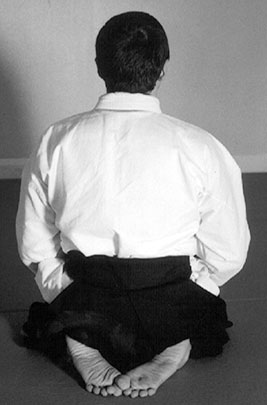

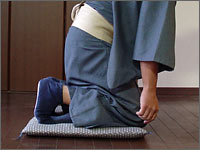




The smaller seiza images are from Kimono wa Fuku.
The seiza position can be hard to maintain for a longer time. So then what ?
The crossed leg position is the acceptable way for men.
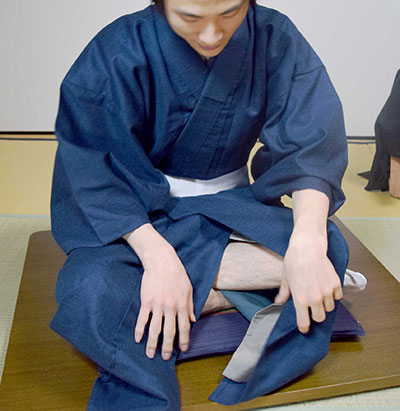


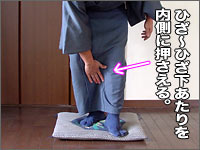 Though, if you want to do your best to limit the view to your crotch you can lightly hold the kimono at knee hight inwards when you are going to sit down in the crossed leg position.
Though, if you want to do your best to limit the view to your crotch you can lightly hold the kimono at knee hight inwards when you are going to sit down in the crossed leg position.After a while when you get used to it, you can just hit the same place lightly inside "Pon!" to get the rigth effect.
If you still feel uncomfortable that the under kimono is showing more then your liking, you can gather the hem and pull them to cover the crotch section.
 Women do not use the crossed legged pose that men use, but position their legs to the side like shown in the right image.
Women do not use the crossed legged pose that men use, but position their legs to the side like shown in the right image.Please do not use this as a man, you will get emberassing smiles and muffled laughs.
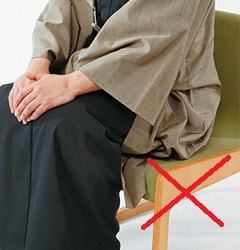
 A last note, when wearing an haori and you are going to sit down, please make sure your buttox won't be on the haori (left image) but pull the haori up so that it does not get confined (right image).
A last note, when wearing an haori and you are going to sit down, please make sure your buttox won't be on the haori (left image) but pull the haori up so that it does not get confined (right image). 
 Same goes for sitting seiza, pull the haori up and spread it to the back when seated.
Same goes for sitting seiza, pull the haori up and spread it to the back when seated.Sitting and standing demonstration video's

男性袴 座り
Sitting down on a chair when wearing an hakama

男性袴 畳 座り
Sitting down on a tatami mat when wearing an hakama
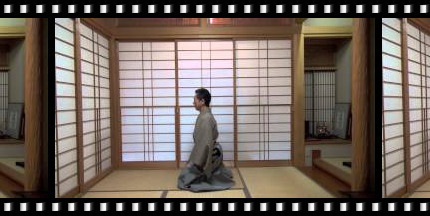
男性袴 畳 立ち
Standing up on a tatami mat when wearing an hakama
Formality levels
Please do not think of these as iron clad rules but suggestions and pointing in the right direction. Use your own common sense (it looks a bit strange to see someone wearing the most formal kimono during a summer fireworks event) and what you feel like.
The fabric of men's kimono is one of the significant factors in telling if a kimono is formal or informal. Silk is more formal, while rayon, polyester, hemp and cotton are less formal. Black silk is the most formal for both men and women.
A kimono with color is inherently less formal than a black version and a rough, 'rustic' pongee is less formal than a smooth silk.
Nowadays, the most casual japanese clothing for anyone is the yukata, but yukata are only appropriate during the summer, at an onsen or in your home, they are extremely casual.
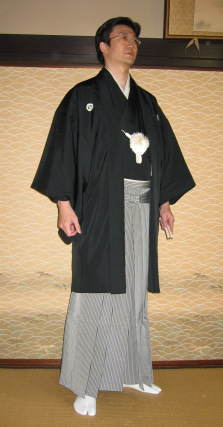 礼装 (reisou)
礼装 (reisou)Formal attire
The most formal attire for men is called kuro montsuki haori hakama (黒紋付き 羽織 袴). This attire consists of a Kimono, Haori and Hakama, together with 5 family crests. Usually worn by the groom or the groom's father at a wedding.
This attire has the most strict rules.
- Haori and Kimono should be black.
- The tabi should be white.
- When wearing a white hada-juban (underwear) one should use a white han-eri for the naga-juban (underkimono), when wearing grey underwear the han-eri should also be light grey.
- The nagajuban is made of hubutai (silk) without an image on the inside back and of a single color.
- The hakama is made from striped sendaihira cloth (千代平) and can be any subdued color, usually grey.
- The haori-himo (羽織紐) should be a white round cord with a pompom (丸組み).
- Regardless of season, a white folding fan (扇子) must be carried.
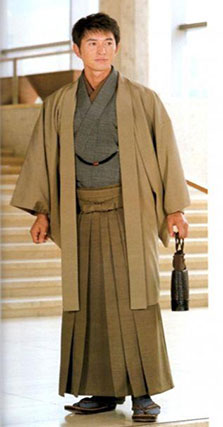 準礼装 (junreisou)
準礼装 (junreisou)Semi-formal attire
When wearing the Kimono, Haori and Hakama and carry a maximum of 3 family crests.
Clothing can be any (subdued) color and the haori-himo may be any kind. The folding fan (扇子) is not to be forgotten. Hakama can be plain or striped.
Worn from a wedding (not being the groom or groom's father) to special celebrations like 80 years old, becoming a Doctor, graduation ceremony, betrothal (rich people) meeting or high class parties.
The formality of the fabric for the kimono and haori is that coloured habutae is more formal than one made from omeshi cloth. For omeshi kimono, it is stylish for the haori to be of a different colour as the kimono (omeshi haori-kimono ensembles are rare, so they are normally made separately out of different bolts of fabric). Interestingly, omeshi kimono are usually cheaper than tsumugi kimono.
 お出掛けのしゃれ着 (odekake no sharegi)
お出掛けのしゃれ着 (odekake no sharegi)Stylish going out attire
Leaving out the Hakama but keeping the Haori on is considered casual, usually worn at casual parties, eating out, stroling around. In short, a comfortable daily kimono set for outdoors.
Fabric can be omeshi, tsumugi or even silk-wool. As a tsumugi kimono is close to daily wear, they cannot be worn as formal wear (to more formal events), no matter how expensive they are. They are usually used for more casual gatherings.
In my opinion this is the outfit most of us will use when leaving the house.
 くつろぎのしゃれ着 (kutsugi no sharegi)
くつろぎのしゃれ着 (kutsugi no sharegi)Relaxation stylish attire
Wearing just the Kimono is considered very casual, usually worn at summer festivals or as daily clothes at home. The summer kimono's made from sha (mesh cloth) or ro (silk gauze) cloth fall also under this catagory.
The outfit when inside and around the house.
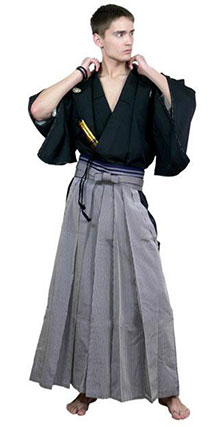 準礼装 (junreisou)
準礼装 (junreisou)Semi-formal attire
Leaving out the Haori but keeping on the Hakama is considered formal, usually worn at a formal party, meetings, martial arts, sometimes at a tea ceremony or if you are a shinto priest.
 浴衣 (yukata)
浴衣 (yukata)Yukata
Yukata, the most informal attire for men, is an unlined dyed cotton kimono for lounging or sleeping in summer. It's worn to enjoy a cool evening breeze or a summer festival in shrines. Worn usually with an heko-obi, tanzen-obi or a thin stiff kaku-obi.
One small note, adult men don't wear an heko-obi outdoors, even when wearing a yukata ;)
Suggested type of kimono during the seasons
In comparison with women Kimono's there aren't much rules for men, you could even say, boring.
These suggestions have been made long time ago and the seasons may have altered a bit.
| August ~ May | : lined kimono (awase kimono, 袷着物) |
| June and September | : unlined kimono (hitoe kimono, 単衣着物) |
| July and August | : Summer kimono or yukata (sha-kimono, ro-kimono, yukata, 紗着物、絽着物、浴衣) |
I have read several times that carrying a folding fan into your obi (put in with your right hand so the handle sticks out to the right and the paper ribs are at the left side of your body) when wearing a summer outfit is a good custom.
When it is hot you can leave the hada-juban out of the equision and add an eri to the naga-juban.
I think it is best to adjust the clothes depending on the weather and event. Please do not wear a lined kimono on a hot day in May which could sometimes compete with mid summer temperatures.
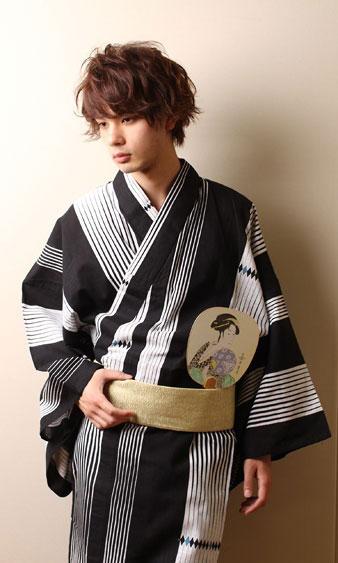 Yukata (cotton kimono)
Yukata (cotton kimono) Ro/Sha summer kimono (very light fabric)
Ro/Sha summer kimono (very light fabric) Unlined kimono
Unlined kimonoWearing a kimono at a funeral
Wearing a kimono for the Tea ceremony
Walking
When you walk, do not drag your feet and do not make loud sounds, thought the gentle clacking (karan koron) of a geta could be considered a welcome and nostalgic sound. When walking, take not too big steps, large steps will expose your underlayers. But be alert on too small steps which could be considered not manly.
The important first step in walking is to make sure that the hanao (thong) of the sandal fits snugly between your big toe and second toe on each foot. Starting with your left foot, take a step forward. Then, start walking in a way where the sole of your foot stays in contact with the sandal (which is ... hard !). This is the basic way to walk. Don't walk like you are wearing flip-flops. Not only does this make it hard to walk, but it also looks and sounds unrefined.
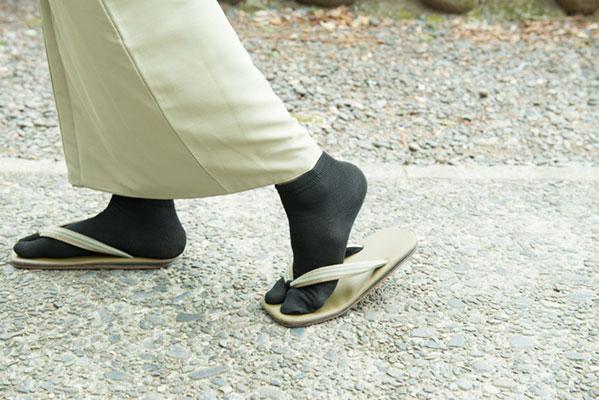 wrong way to walk
wrong way to walk right way to walk
right way to walk(The original page where above images came from can be found at JP Etiquette)
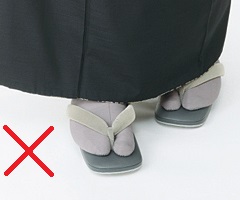 Don't look at women to find out how to walk, those inward small steps are for them only :)
Don't look at women to find out how to walk, those inward small steps are for them only :)Men can walk with farther strides (to a limit) and without inward movements.
(The original page where above and below image came from can be found at Nikkei Trendy net)
 A man walking with a small stride is not very chic, it just does not look nice.
A man walking with a small stride is not very chic, it just does not look nice.But walking with larger steps is kind of difficult initially.
In order to solve this, let's do some 'crotch split' 「股割り」 .
Once you have put on a kimono, you open your feet to the shoulder width, firmly squat down and do "crotch split (squat)". By doing so, you can improve your hem judgment and you can walk with unchanging strides.
An Edo period (1603-1868) style of walking that can be used when wearing a kimono is called Namba Aruki (なんば歩き).
Quote from Tofugu's walking guide:
If you’re wearing a kimono Namba Aruki will also make it so it doesn’t get rumpled up (because you don’t move your hips or upper body back and forth like with normal walking). Also, if you have a sword at your hip walking in the Namba style will prevent the sword from swinging side to side, which would get irritating after a while (and make it harder to draw while you’re running). Lastly, if you’re wearing geta and walking through the muddy streets, this style of walking would prevent you from splashing said mud up the back of your hakama or pants, or even onto other people. So, even beyond the express runners there were many reasons for people to walk this way in Edo era Japan.
When you do Namba Aruki, you move your left arm and left leg forward at the same time. Then, you move your right arm and right leg forward at the same time.
If you want to learn how to walk Namba Aruki style please check out the Namba Aruki Guide by Koichi (tofugu)
Climbing the stairs
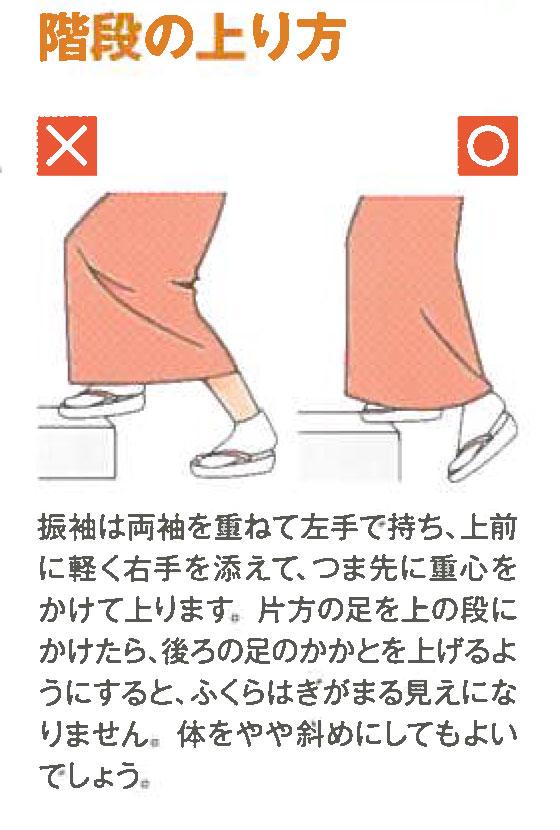 As you will quickly notice when wearing a kimono and start to climb a stair, the lower part of the kimono will have a tendency to hug the shoes/feet almost tripping you in the process. A simple way to prevent that is to put your feet closer to the step so that your motion becomes more vertical instead of forward.
As you will quickly notice when wearing a kimono and start to climb a stair, the lower part of the kimono will have a tendency to hug the shoes/feet almost tripping you in the process. A simple way to prevent that is to put your feet closer to the step so that your motion becomes more vertical instead of forward.When wearing an hakama it gets a little bit more difficult to manage stairs without pulling the garment up, so enjoy these two video's i've found.
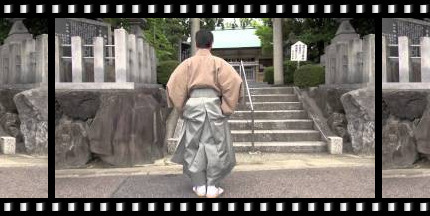
男性袴 階段 昇り
Climbing the stairs with an hakama
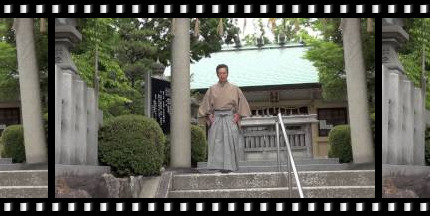
男性袴 階段 降り
Descending the stairs with an hakama
Carrying things, some ideas
Carry things with a small bag
Carry luggage as much as possible with your left hand or shoulder. Hold the umbrella in the right hand.
Also a possibility is carrying the object (like a cell phone) attached to your obi belt with a 'netsuke' and a cord. (right image)
Click here for more different kimono bags
 Schoulder bag
Schoulder bag Hand bag
Hand bag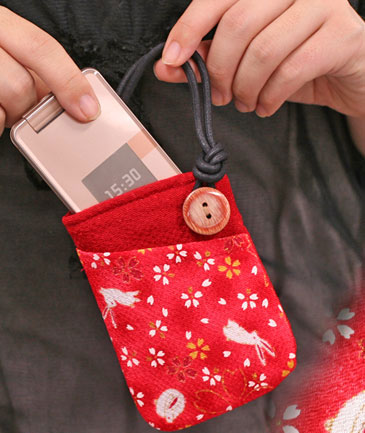 Cell Phone Pouch
Cell Phone PouchCarry things in your sleeve.
 Small things like cash, handkerchief, tenui (small cloth towel), housekey and so can be put into the sleeve. Use the wide sleeve opening at your hand to take things out or put in the sleeve. You don't have to worry that they will fall out, they remain firmly in the sleeve.
Small things like cash, handkerchief, tenui (small cloth towel), housekey and so can be put into the sleeve. Use the wide sleeve opening at your hand to take things out or put in the sleeve. You don't have to worry that they will fall out, they remain firmly in the sleeve. For people who have gone to a tea ceremony and had sweets already know that "dirty" things go into the left sleeve aka "personal rubbish bin". By that logic you put your things standard in the right sleeve. (Feel free to mail me if you can provide more info about this)
Carry things at your breast/stomach
 If you don't or can't carry a small bag you can wrap your cellphone into a small cloth or nice fabric case and tuck it inside your kimono just above the obi belt.
If you don't or can't carry a small bag you can wrap your cellphone into a small cloth or nice fabric case and tuck it inside your kimono just above the obi belt.Carry things tucked in the obi
Stiff objects like a smoking pipe, folding fan, mp3 player may be tucked in the obi.
 Stif round summer fan (uchiwa - 団扇) for the yukata or summer kimono is worn at the back
Stif round summer fan (uchiwa - 団扇) for the yukata or summer kimono is worn at the back Netsuke (根付) with an inro (印籠), a pill box or tabaco box, can be worn at the front right with the rope behind the obi.
Netsuke (根付) with an inro (印籠), a pill box or tabaco box, can be worn at the front right with the rope behind the obi.The folding fan (sensu) at the left pointing to the right for easy acccess. Which part is placed on top, the handle or the fan, rule is still uncertain for me.
 The inro can also be worn at the back side to the right
The inro can also be worn at the back side to the right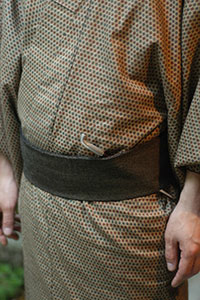 Japanese smoking pipe (Kiseru - 煙管) tucked in the obi.
Japanese smoking pipe (Kiseru - 煙管) tucked in the obi. A finely shredded tobacco product resembling hair (Kizami - 刻み) for the smoking pipe
A finely shredded tobacco product resembling hair (Kizami - 刻み) for the smoking pipe One way of carrying a smoking set is in the obi a long container with the smoking pipe and the inro could contain the tabaco and lighter.
One way of carrying a smoking set is in the obi a long container with the smoking pipe and the inro could contain the tabaco and lighter.Raising your hand
 When raising a hand to call out for a taxi or making a phone call with your mobile phone, please hold the kimono sleeve at the end with your left arm so to not expose your bare arm. It's bad manners and improper form to show your bare arm.
When raising a hand to call out for a taxi or making a phone call with your mobile phone, please hold the kimono sleeve at the end with your left arm so to not expose your bare arm. It's bad manners and improper form to show your bare arm.This probably also goes for men, no-one wants to see those hairy arms I think :D
Though, have not found any conclusive information about this for men if this behaviour is.
Entering a car
When entering a car, put your bag in the middle of the seat, ① stand with your back to the door and sit. ② Align the legs and ③ rotate to enter the car. Do not sit with your back against the back of the seat, but sit a bit more forward leaving room for your musubi (knot) not to be crushed by the seat (though the flat knots for men this doesn't pose a problem). Please take caution to avoid hooking the sleeves when entering the car and make sure everything is inside when the door closes.

But isn't it much more fun to use the "taxi's" depicted below ?
 Jinrikuzori 人力轌 (man powered sleigh)
Jinrikuzori 人力轌 (man powered sleigh)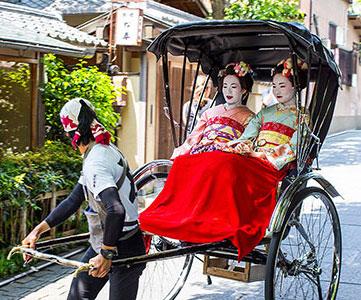 Jinrikusha (man powered vehicle) 人力車
Jinrikusha (man powered vehicle) 人力車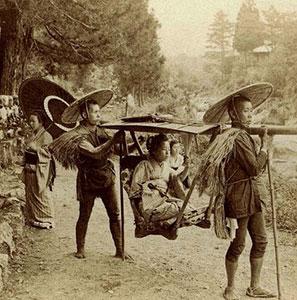 Yama kago 山籠 ? Meji (1868-1912) era
Yama kago 山籠 ? Meji (1868-1912) eraPicking up things
The following text is written for women, not sure if these actions also apply to men
At least the moral of the story is: be carefull to not get your hem or sleeves dirty when picking up things.
If you need to pick something up, stand next to the item with one foot. Then, take a half step with the other foot and lower yourself down vertically by bending at the knees. Once you are low enough, gracefully pick up the item. Take care when you outstretch your arm to pick the item up. If you are wearing a long-sleeved kimono, you don't want to let the sleeve touch the ground since it would become soiled. So, please pay close attention when reaching for something where the sleeves might get dirty.
 (will try to replace this image with a male version once I have found that illusive photo)
(will try to replace this image with a male version once I have found that illusive photo)Eating and drinking in a kimono
So as not to pollute the kimono please use a handkerchief or napkin. A large-sized will the better choice, one time folded.
 You can use the napkin at the neck
You can use the napkin at the neck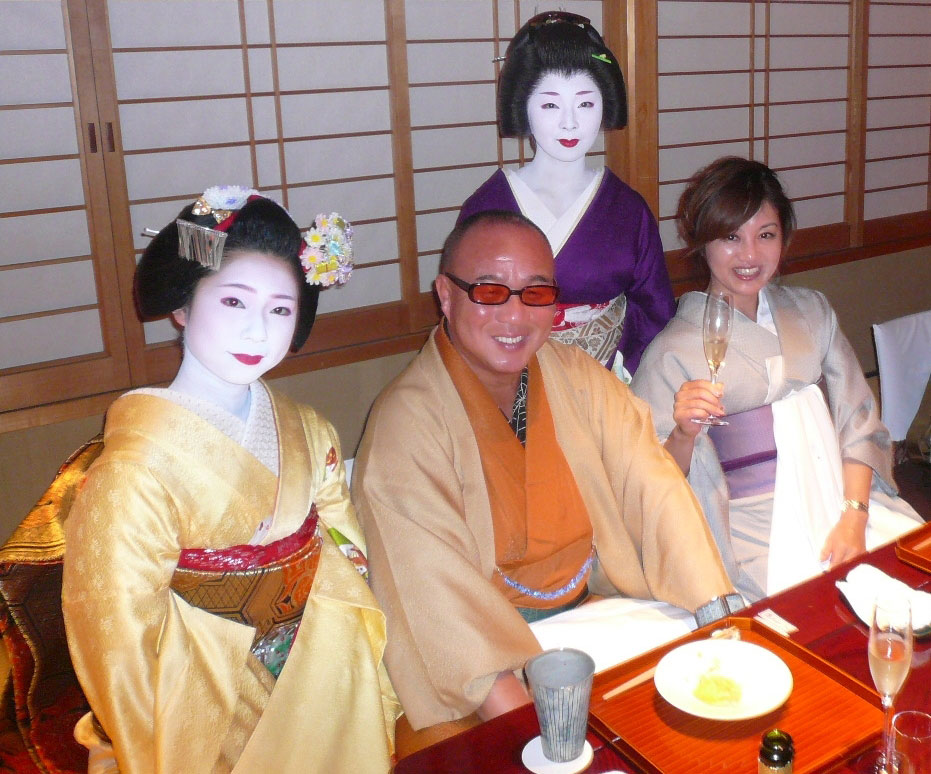 on top of the knees or tucked at the top of the obi
on top of the knees or tucked at the top of the obi or none at all (for who do not mind stains)
or none at all (for who do not mind stains)Please do not lean over the dish when eating, this is called inu-gui (sloppy eater).
When reaching for an item
Just like other clothes, stains can be difficult to remove, in the case of a kimono it can also be very expensive. The reality is that kimono sleeves and the front V-neck area have a tendency to attract stains.
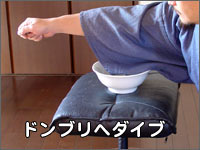 Reaching for an item can bring hazards to your kimono sleeve
Reaching for an item can bring hazards to your kimono sleeve or the items which are in the path of the sleeve.
or the items which are in the path of the sleeve. The right way to reach for an item in a kimono, hold the sleeve back with the other hand.
The right way to reach for an item in a kimono, hold the sleeve back with the other hand.Above images are from Kimono wa Fuku.
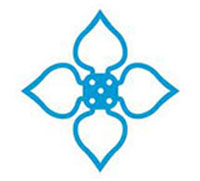


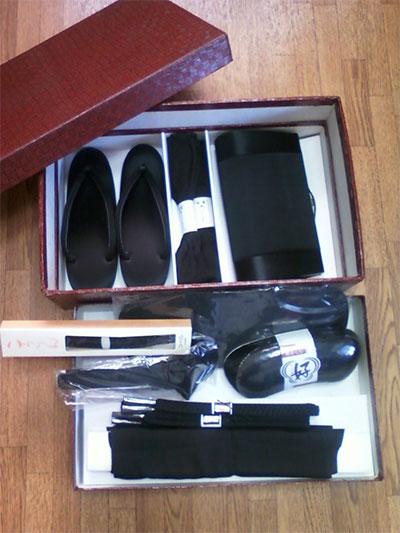 When going to a funaral one wears a mofuku (mourning kimono), an all black ensemble, everything, even the koshi-himo (strings) is black. (though i have seen an photo where the tabi was white).
When going to a funaral one wears a mofuku (mourning kimono), an all black ensemble, everything, even the koshi-himo (strings) is black. (though i have seen an photo where the tabi was white). 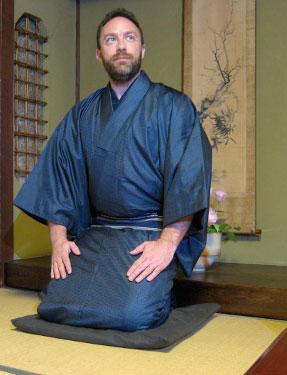 I believe that the musubi of the obi and the color of the kimono can be played with depending on the situation and teacher. There is a difference between a joyous Hatsugama (boiling of the first kettle of the year tea ceremony), the haiku enticing Yuuzari-no-chaji (early-evening tea ceremony held in the warmer months) and a keiko, where you try to learn (or just enjoy) by watching the teacher make tea.
I believe that the musubi of the obi and the color of the kimono can be played with depending on the situation and teacher. There is a difference between a joyous Hatsugama (boiling of the first kettle of the year tea ceremony), the haiku enticing Yuuzari-no-chaji (early-evening tea ceremony held in the warmer months) and a keiko, where you try to learn (or just enjoy) by watching the teacher make tea.